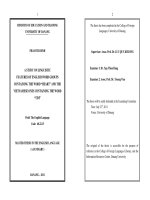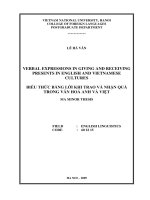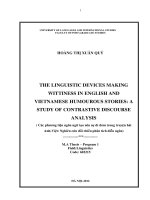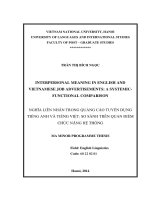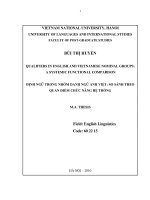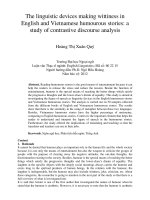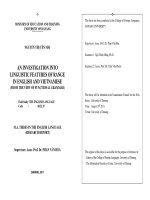interpersonal meaning in english and vietnamese job advertisements a systemic functional comparison = nghĩa liên nhân trong quảng cáo tuyển dụng tiếng anh và tiếng việt so sánh trên quan điểm chức năng hệ thống
Bạn đang xem bản rút gọn của tài liệu. Xem và tải ngay bản đầy đủ của tài liệu tại đây (1.5 MB, 89 trang )
VIETNAM NATIONAL UNIVERSITY, HANOI
UNIVERSITY OF LANGUAGES AND INTERNATIONAL STUDIES
FACULTY OF POST – GRADUATE STUDIES
************
TRẦN THỊ BÍCH NGỌC
INTERPERSONAL MEANING IN ENGLISH AND
VIETNAMESE JOB ADVERTISEMENTS: A SYSTEMIC-
FUNCTIONAL COMPARISON
NGHĨA LIÊN NHÂN TRONG QUẢNG CÁO TUYỂN DỤNG
TIẾNG ANH VÀ TIẾNG VIỆT: SO SÁNH TRÊN QUAN ĐIỂM
CHỨC NĂNG HỆ THỐNG
MA MINOR PROGRAMME THESIS
Field: English Linguistics
Code: 60 22 02 01
Hanoi, 2014
VIETNAM NATIONAL UNIVERSITY, HANOI
UNIVERSITY OF LANGUAGES AND INTERNATIONAL STUDIES
FACULTY OF POST – GRADUATE STUDIES
************
TRẦN THỊ BÍCH NGỌC
INTERPERSONAL MEANING IN ENGLISH AND
VIETNAMESE JOB ADVERTISEMENTS: A SYSTEMIC-
FUNCTIONAL COMPARISON
NGHĨA LIÊN NHÂN TRONG QUẢNG CÁO TUYỂN DỤNG
TIẾNG ANH VÀ TIẾNG VIỆT: SO SÁNH TRÊN QUAN ĐIỂM
CHỨC NĂNG HỆ THỐNG
MA MINOR PROGRAMME THESIS
Field: English Linguistics
Code: 60 22 02 01
Supervisor: Prof. Dr. Hoàng Văn Vân
Hanoi, 2014
i
DECLARATION
I hereby certify that the thesis entitled “Interpersonal Meaning in English and
Vietnamese Job Advertisements: A Systemic-Functional Comparison” is entirely the
result of my own research unless otherwise referenced or acknowledged. The thesis
has not been submitted for degree at any other academic institution.
Hanoi, January 2014
Tran Thi Bich Ngoc
ii
ACKNOWLEDGEMENTS
This thesis could not have been achieved without the advice, encouragement and
support from my instructors, colleagues, classmates and my family.
First and foremost, I would particularly like to express my deepest gratitude to my
supervisor, Prof. Hoang Van Van for his invaluable guidance, criticism and his
encouragement throughout my research.
My special thanks go to all instructors and the staff of the Faculty of Post-Graduate
Studies, University of Languages and International Studies, Vietnam National
University, Hanoi for their useful lectures and assistance during my study.
I am also very grateful to my colleagues, my friends and classmates at University of
Languages and International Studies for their precious support and sincere
comments.
Last but not least, I would like to acknowledge my debt to my beloved family who
have given me unconditioned love and encouragement, which is very significant for
me to fulfill this work.
iii
ABSTRACT
The present thesis endeavors to make a contrastive analysis of the basic
realization of interpersonal meaning in the discourse of English and Vietnamese job
advertisements. A corpus of fifteen English job advertisements and fifteen
Vietnamese ones are selected from the well-known English and Vietnamese
recruitment websites at random to carry out the research work. Under the theoretical
framework of Halliday’s systemic functional grammar, the three linguistic patterns:
mood, modality and person system of the target text have been scrutinized
respectively. The study demonstrates how interpersonal meaning is realized under
different social and cultural background. It is revealed that although English job
advertisements and Vietnamese ones share a few similarities in terms of the
realization of interpersonal meaning, there still exist certain disparities. The main
similarities include preferred declarative mood, preferred first person pronouns and
probability with the highest frequency. The major differences are as follows:
English job advertisements employ more interrogatives and imperatives than the
Vietnamese counterparts; the English samples use more obligation and personal
pronouns than Vietnamese ones. These disparities can be interpreted by considering
the social and cultural differences. By making a comprehensive and detailed study,
this thesis is a meaningful application of systemic functional grammar to the
discourse of job advertisements. It is expected that this study can be useful for both
job advertisers and job hunters. It is also hoped that the findings in the research can
be helpful for teaching writing, translating and serve as reference in ESL linguistics
classes where SFG is introduced.
iv
TABLE OF CONTENTS
DECLARATION…………………………………………………………………i
ACKNOWLEDGEMENTS ii
ABSTRACT iii
TABLE OF CONTENTS iv
LIST OF TABLES AND FIGURES vi
LIST OF ABBREVIATIONS vii
PART A: INTRODUCTION 1
1.1. Rationale of the study 1
1.2. Significance of the study 2
1.3. Aims of the study and research questions 2
1.4. Methodology 2
1.5. Design of the study 4
PART B: DEVELOPMENT 5
CHAPTER 1: THEORETICAL BACKGROUND 5
1.1. An investigation into interpersonal meaning 5
1.1.1. Mood 6
1.1.2. Modality 9
1.1.3. The person system 12
1.2. Tenor of job advertisements 13
1.2.1. Context of situation 13
1.2.2. Tenor: the interpersonal variable of the context of situation 14
1.2.3. Tenor of job advertisements 15
v
CHAPTER 2: A CONTRASTIVE ANALYSIS OF INTERPERSONAL
MEANING IN ENGLISH AND VIETNAMESE JOB ADVERTISEMENTS
2.1. A contrastive analysis in terms of mood 16
2.1.1. Speech roles in job advertisements and mood structures 16
2.1.2. Information-giving 18
2.1.3. Action-demanding 22
2.1.4. Summary 24
2.2. A contrastive analysis in terms of modality 25
2.2.1. Modalization 26
2.2.2. Modulation 30
2.2.3. Summary. 33
2.3. A contrastive analysis in terms of the person system 35
2.3.1. The first person system 36
2.3.2. The second person system 37
2.3.3. The third person system 38
2.3.4. Summary 39
PART C: CONCLUSION 40
1. Recapitulation 40
2. Implications of the study 42
3. Limitations and suggestions for further study 43
REFERENCES 44
APPENDIX 1 I
APPENDIX 2 XIX
vi
LIST OF TABLES
Table 1.1 Speech functions and commodities exchanged ………………6
Table 1.2 Speech functions and typical mood of clause 6
Table 1.3 Modalization and modulation 10
Table 1.4 Modal operators 11
Table 1.5 Modality: examples of ―type‖ and orientation combined 11
Table 2.1 Distribution and frequency of mood structures in the samples of
English job advertisements 17
Table 2.2 Distribution and frequency of mood structures in the samples of
Vietnamese job advertisements 17
Table 2.3 Distribution and frequency of probability in English and Vietnamese
job advertisements 26
Table 2.4 Distribution and frequency of obligation in English and Vietnamese
job advertisements. 30
Table 2.5 Distribution and frequency of modality in English and Vietnamese
job advertisements 33
Table 2.6 Distribution and frequency of the person system in English and
Vietnamese job advertisements 35
LIST OF FIGURES
Figure 1.1 The power continuum 4
Figure 1.2 The contact continuum 14
Figure 1.3 The affective involvement continuum 14
vii
LIST OF ABBREVIATIONS
ESL
English as Second Language
SFG
Systemic Functional Grammar
SFL
Systemic Functional Linguistics
1
PART A: INTRODUCTION
1. Rationale of the study
Not only is language used to represent the interlocutors’ experience of the world
around them, but also to express interpersonal meaning, the function language used to
interact with other people in order to establish and maintain the relationship between
them as well as to reflect the writer’s attitude towards the subject matter (Halliday,
1994). Since language is an effective means of communication, interpersonal meaning
is an indispensable component among the three meta-functions in Halliday’s Systemic
Functional Grammar (SFG).
Interpersonal meaning has recently become a matter of great concern among
researchers. Until now, there have been a considerable number of studies on
interpersonal meaning of different types of discourses on the basis of SFG ranging
from political speeches, fundraisings to advertisements. Among all these discourses,
advertising is the most contacted in our current society. Within the field of
advertisements, there are studies on interpersonal meaning in advertising in general
or particularly in different types of advertisements. A distinctive example of the study
on interpersonal meaning in English advertising is the research by Xiao-xia (2008).
It was found that advertisers employ the mood systems and person system to create
an intimate atmosphere, thus enhancing the interactivity and trustworthiness.
Different kinds of advertisements have also been studied in recent years like the
study on hotel and apartment advertisements by Sinaga (2012) or political
advertisements in some Nigerian newspapers by Olusanya (2013).
As a sub-category of advertisements, job advertisements belong to the persuasive
genre with the aim of establishing the relationship between the recruiters and potential
applicants; therefore, they contribute as a fruitful source for researchers to carry out
studies on interpersonal meaning. However, it is revealed that most research mainly
focused on English recruitment advertising discourse like studies by Yan & Li (2007)
and Liang (2009). Those on Vietnamese job advertisements are seldom found not to
mention the comparative study on interpersonal meaning in English and Vietnamese
2
job advertisements. This has instigated the researcher to conduct an investigation on
the interpersonal meaning in the discourse of English and Vietnamese job
advertisements since the realization of interpersonal meaning can vary in different
cultural and social contexts.
2. Significance of the study
The focus of the study not only lies in the theoretical findings, but it is hoped that
it will also emerge as a practical application of the theory to the description and
analysis of job advertisements. Practically speaking, the analysis of interpersonal
meaning in job advertisements can give illuminations to job advertisers and job
hunters. Moreover, the contrastive analysis of interpersonal meaning in English and
Vietnamese job advertising texts is hoped to be useful for teaching practical English
writing, translating and serving as a reference to be employed in ESL linguistics
classes where Halliday’s theory of SFG is introduced.
3. Aims of the study and research questions
The overarching aim of this thesis is to investigate the realization of
interpersonal meaning in English and Vietnamese job advertisements and to
establish the similarities and differences in the realization of interpersonal meaning
in the job advertisements of the two languages. To achieve this aim, the following
research questions are raised:
1. How is interpersonal meaning realized lexico-grammatically in English
and Vietnamese job advertisements?
2. What are the similarities and differences between English and Vietnamese
job advertisements in terms of the realization of interpersonal meaning?
4. Methodology
A variety of job advertisements can be issued through numerous ways from
traditional channels such as TV, the daily and periodical press, poster to new
channels like the Internet. This thesis only focuses on those issued on the Internet
because more and more corporations currently apply the way of recruiting through
the net to take more potential talents. To carry out the comparison between the
3
advertisements in the two languages, a corpus of fifteen English and fifteen
Vietnamese advertisement texts were collected. The Vietnamese data were selected
from www.vietnamworks.com, the top recruitment website in Vietnam. Likewise,
the English corpus was chosen from www.monster.com , one of the largest and most
reliable professional recruiting website in America. All of the thirty job
advertisements are listed in Appendices 1 and 2. In the process of data collection, to
avoid the limitation of singularity in one field, the author tried to concern as many
domains as possible, such as accounting, education, banking, constructing, tourism,
and so forth. For the sake of convenience, the letter E followed by a number of data
ranging from 1 to 15 refers to the English job advertisements while the letter V to
the Vietnamese job advertisements. The main subject of this research is the written
discourse of job advertisement; therefore, the titles, slogans and image of the
company are not taken into consideration.
The present research aims to investigate the realization of interpersonal
meaning in the discourse of job advertisements in English and Vietnamese from the
perspective of systemic functional grammar. Therefore, this study brings in the
Hallidayian Systemic Functional Linguistics (SFL) model of text analysis as the
theoretical framework for the analysis and comparison of the job advertisement
texts. According to Halliday (1994), the mood and modality systems are the basic
means to realize interpersonal meaning lexico-grammatically in the clause. Later,
pronoun system, attitudinal modifier and rhythmic features of word are also added.
The researcher made a critical view of the previous studies of interpersonal meaning
and intended to analyze the realization of interpersonal meaning from three aspects:
mood, modality, and the person system.
The analytical procedure is made up of three steps. First, the representations of
mood, modality and person system in English and Vietnamese job advertisements
were identified. Second, the frequencies of the above-mentioned expressions in
English and Vietnamese corpus were counted respectively, and then the figures
were listed in a table to show similarities and differences between English and
4
Vietnamese job advertisements. Finally, the study gave an interpretation of these
similarities and differences by taking cultural and social differences into
consideration.
5. Design of the study
The study is made up of three parts.
Part A provides an introduction to the whole thesis, including the rationale for
selecting the topic, the significance and aims of the study, the methodology,
and the design of the study.
Part B, the main part of the thesis, consists of two chapters.
o Chapter 1 provides an overview of interpersonal meaning. It also gives an account
of the tenor of job advertisement as a discourse of the current research.
o Chapter 2 presents a contrastive analysis of the interpersonal meaning in English
and Vietnamese job advertisements. A detailed analysis of mood, modality and the
person system is carried out on the data from English and Vietnamese corpus.
Part C summarizes the results of the study; makes some implications for teaching
and learning English as well as suggestions for further research.
5
PART B: DEVELOPMENT
CHAPTER 1
THEORETICAL BACKGROUND
As the title suggests, this study applies the theory of Systemic Functional
Grammar (SFG) to the analysis of interpersonal meaning in the discourse of job
advertisements in English and Vietnamese. To set the framework for analysis, this
chapter provides a review of the interpersonal meaning as conceptualized in SFG. In
the first place, the notion of interpersonal meaning will be examined. This will be
followed by an account of tenor of job advertisements.
1.1. An investigation into interpersonal meaning
Halliday and Matthiesen (2004), as cited in Eggins (2004: 144), state that
―whenever we use language to interact, one of the things we are doing with it is
establishing a relationship between us: between the person speaking now and the
person who will probably speak next.‖ At this point, grammar of interaction is seen
from a semantic perspective.
According to Matthiessen (1995), the interpersonal meaning is considered to
be ―a resource for enacting social roles and relationships between speaker/writer
and listener/reader.‖ (1995: 17)
Meanwhile, Thompson explains the interpersonal meaning as
―We use language to interact with other people, to establish and maintain
relations with them, to influence their behavior, to express our own viewpoints
on things in the world, and to elicit or change theirs.’’
(Thompson, 2004: 30)
In short, the most important task of the interpersonal meaning is to establish
and maintain a social relationship between participants. It relates to the text’s aspect
of tenor which combines three component areas: status, contact and affect.
Interpersonal meaning mainly concerns the roles of addressers and audience, mood
and modality.
6
1.1.1. Mood
1.1.1.1. Speech roles and speech functions
Mood is an indispensable component for the construction of social relationship
between the writer/speaker and the reader/listener. Halliday (1994: 18) points out
that ―the most fundamental types of speech role, which lies behind all the more
specific types that we may eventually be able to recognize, are just two (i) giving,
and (ii) demanding‖. According to Halliday (1994: 69), in any communicative
language, there are four basic interpersonal positions a speaker can adopt: giving
information, demanding information, giving goods and service as well as
demanding goods and services. The combination of speech roles and commodities
represents several speech functions including offer, command, statement and
question. The exchange of speech function and commodities is shown in Table 1.1
below.
Role in
exchange
Commodity exchanged
(a) (a) goods-&-services
(b) information
(i)giving
―offer‖
would you like this teapot?
―statement‖
he’s giving her the teapot
(ii) demanding
―command‖
give me that teapot!
―question‖
what is he giving her?
Table 1.1 Speech functions and commodities exchanged (Halliday, 1994: 69)
1.1.1.2. Typical mood structures
The four basic speech functions are closely related with particular grammatical
structures. The relationship between forms of speech functions and typical mood
clauses is illustrated in Table 1.2 as follows:
Speech function
Typical mood in clause
Command
―imperative mood‖
Close the door.
Offer
―modulated interrogative mood‖
Would you like to have dinner with me?
Statement
―declarative mood‖
It was one of Shakespeare’s works.
Question
―interrogative mood‖
What are you going to do tonight?
Table 1.2 Speech functions and typical mood of clause (Adapted from Eggins, 2004: 148)
7
In the interpersonal meaning, a clause in English is analyzed into Mood and
Residue, with the mood element is made up of Subject and Finite. Subject ―supplies
the rest of what it takes to form a proposition, namely, something by reference
which the proposition can be affirmed or denied‖ (Halliday, 1994: 76). The Finite
aims to make the proposition finite and relates the proposition to the context in the
speech event. The Finite expressing tense and modality is part of a verbal group.
The Residue consists of functional elements of three kinds: Predicator, Complement
and Adjunct of the clause.
In SFG, the structure of the declarative, interrogative and imperative clauses is
shown by the presence and ordering of Subject and Finite. According to Halliday
(1994: 74), the presence of the Mood element consisting of Subject plus Finite,
realizes the feature ―indicative‖. Declarative is realized through the typical structure
of Subject preceding Finite. For example:
Declarative clause
Tom
is
reading
Oliver Twist
Subject
Finite
Predicator
Complement
Mood
Residue
The typical structure of an interrogative clause is divided into two main types:
polar interrogative (yes/no question type) with the order of Finite before Subject
and Wh-question with the order of Subject before Finite if the Wh-element is the
subject and the order of Finite before Subject otherwise.
Yes/No interrogative clause
Is
Linda
writing
a letter?
Finite
Subject
Predicator
Complement
Mood
Residue
Wh-element conflated with Subject
What
happened?
Subject/WH-
Finite
Predicator
Mood
Residue
8
WH-interrogative clause
Where
do
you
live?
Adjunct/WH-
Finite
Subject
Predicator
Mood
Residue
Eggins (2004) describes fours types of imperative structures including (i) an
imperative with no Mood element, an imperative consisting of a Mood element of
(ii) Finite only or (iii) Subject only, and an imperative with a Mood element in the
order of Finite preceding Subject. Types of imperative structures are illustrated in
the following examples:
(i)
Listen!
(ii)
Don’t
talk!
Predicator
Finite
Predicator
Residue
Mood
Residue
(iii)
You
Listen!
(iv)
Don’t
you
borrow
her book!
Subject
Predicator
Finite
Subject
Predicator
Complement
Mood
Residue
Mood
Residue
Halliday and Matthiesen (2004) assert that the Mood element comprising
Subject and Finite is the element that realizes the selection of mood in the clause. It
is worth noting, here, that Halliday and Matthiesen (2004) also make a note of the
different realizations of mood under different social and cultural contexts.
According to them, the sequence of Subject and Finite serving to realize the
selection of mood in the clause is ―being restricted mainly to certain languages from
Europe. It is far more common for languages to use tone (as English also does)
and/or special interpersonal mood particles as in languages in East and South-East
Asia (as in Chinese, Vietnamese, Japanese and Thai)‖ (Halliday and Matthiesen
(2004:113). These mood particles tend to come at the beginning or at the end of the
clause and serve the interpersonal function of Negotiator.
For example, in Vietnamese yes-no interrogative clause, there does not appear
inversion of Subject and Finite. Word order in Vietnamese yes-no interrogative
clauses are the same as in declarative ones with Subject preceding Predicator.
Vietnamese questions are like narrative sentences but at the same time they are
9
often combined with modal particles like à, hả or some pairs of adverb like có
chưa, có không, có phải không to make questions. The following example shows an
analysis of a yes/no interrogative clause in English and Vietnamese with respect to
its interpersonal meaning.
English
Vietnamese
Do
you
know
her?
Anh
biết
cô ấy
không?
Finite
Subject
Predicator
Complement
Subject
Predicator
Complement
Mood
Particle
Mood
Residue
Mood
Residue
Mood
1.1.1.3. Grammatical metaphors of mood
Thompson (2000) states that the expression of meaning can be achieved
through a lexico-grammatical form which originally evolved to express a different
kind of meaning. Compared with the typical mood structures as discussed above,
the four basic speech functions are also realized by less typical or non-typical
structures which are called grammatical metaphor of mood (Halliday, 1994). The
use of grammatical metaphor is much popular in people’s daily interaction. For
example, command is typically realized by imperative mood but can be expressed
by a large variety of expressions as illustrated below.
a. Show me the car!
b. Tell me where you parked the car, please.
c. Could you tell me where you parked the car, please?
d. I would advise you to tell me where you parked the car
e. It is advisable to tell me where you parked the car.
1.1.2. Modality
1.1.2.1. Definition and types of modality
Halliday (1994) asserts the importance of modality in carrying out the
interpersonal meaning of clauses. He states that the speaker through modality can
take up a position and show the status and the validity of the proposition. Modality
is a degree between the positive and negative poles reflecting the speaker’s
10
judgments. What the modality system does is to construe the region of uncertainty
that lies between ―yes‖ and ―no‖ (Halliday and Matthiessen, 2004: 147).
Modality is classified differently according to different linguists. Palmer
(1986) distinguishes two main types of modality: epistemic and root modality.
Quirk et al. (1985: 219) call these extrinsic (human judgment of what is or is not
likely to happen) and intrinsic (some kind of intrinsic human control over events).
In SFG, modality is categorized into modalization and modulation. This division
originates from the distinction between proposition (information, i.e. statements and
questions) and proposals (goods and services, i.e. offers and commands). If
information is the exchanged commodity, modality expressions are termed as
―modalization‖ which relates to the validity of the proposition and covers the scale
of degrees of probability (possibly/ probably/ certainly) and usuality (sometimes/
usually/always). Meanwhile, Modulation is used to label modality if the commodity
is goods and services and the clause is termed ―proposal‖. It reflects how confident
the speaker can be in the eventual success of the exchange in terms of obligation
(allowed to/ supposed to/ required to) in a command and the inclination (willing to/
anxious to/ determined) in an offer.
1.1.2.2. Realization of modality
In traditional grammar, the realization of modality is mainly through modal
operators, which are also labeled modal auxiliary such as could, can, will, may. In
SFG, according to Halliday (1994), there are a number of ways to realize modality,
as illustrated in Table 1.3 below.
Types of intermediacy
Typical realization
Example
modalization
probability
(possible
/probable
/certain)
finite modal operator
modal Adjunct
(both the above)
They must have known
They certainly knew
They certainly must have
known
usuality
(sometimes
/usually
/always)
finite modal operator
modal Adjunct
(both the above)
It must happen
It always happen
It must always happen
modulation
obligation
(allowed
finite modal operator
passive verb Predicator
You must be patient!
You’re required to be patient!
11
/supposed
/required)
inclination
(willing
/keen
/determined)
finite modal operator
adjective Predicator
I must win!
I’m determined to win!
Table 1.3 Modalization and modulation (Adapted from Halliday, 1994: 91)
According to Halliday (1994), there are three basic values of modal operators
which are high, median and low modal operators, as shown in Table 1.4 below.
low
median
high
positive
can, may, could,
might(dare)
will, would, should,
is/was to
must, ought to, need,
has/had to
negative
needn’t,
doesn’t/didn’t +need
to, have to
won’t, wouldn’t,
shouldn’t,
(isn’t/wasn’t to)
mustn’t, oughtn’t to, can’t,
couldn’t(mayn’t, mightn’t,
hasn’t/hadn’t to)
Table 1.4 Modal operators (Halliday, 1994: 76)
Interpersonal metaphor is also studied by Halliday (1994) as a means of
modality realization. Halliday (1994: 357) claims that it is modality orientation that
determines how each modality meaning gets expressed. The relationship between
different types of modality and orientation is shown in Table 1.5 below.
Subjective:
explicit
Subjective:
implicit
Objective:
implicit
Objective:
explicit
Modalization:
Probability
I think [in my
opinion] Mary
knows
Mary’ll know
Mary probably
knows[in all
probability]
It’s likely that
Mary knows
[Mary is likely to]
Modalization:
Usuality
Fred’ll sit
quite quiet
Fred usually sits
quite quiet
It’s usual for Fred
to sit quite quiet
Modulation:
obligation
I want John to
go
John should
go
John’s supposed
to go
It’s expected that
John goes
Modulation:
Inclination
Jane’ll help
Jane’s keen to
help
Table 1.5 Modality: examples of ―type‖ and orientation combined (Halliday, 1994: 358)
It is shown in Table 1.5 that both the subjective explicit orientation and the
objective explicit orientation are based on metaphor, i.e. expressions of modality are
extended from words to clauses by adding projecting clauses such as I think, It’s
likely that, It’s usual that, I want you. It can be concluded that metaphor of modality
12
can reasonably arrange information according to modality responsibility so as to
create the pragmatic function of modality in discourse.
1.1.3. The person system
The person system has been the subject of many scholars’ linguistic research
and studies. As a grammatical category, in traditional grammar, the person system is
a closed system concerned with the quantity and quality of participants in a specific
situation. That means personal pronouns are only discussed in terms of their form
and syntactic function. However, since the introduction of discourse analysis and
sociolinguistics in the 1980s, personal pronouns have been viewed from the
approach of social linguistics. According to Li (2001), their use is considered to be
important to the achievement of social function like exerting effects and expressing
politeness in recent studies. In SFG, Halliday (1994) states that the person system,
both as pronouns (person as Thing, e.g. she, you) and as possessives (person as
Deictic, e.g. her, your) can also be deployed to express the interpersonal meaning.
Personal pronouns can establish a certain relationship between the addressers
and the audience in a speech. According to Stephan & Patzold (1992), the selection
of personal pronouns (e.g. I, we, and you) can affect the degree of distance or
closeness between the writer/speaker and the reader/listener. In other words, certain
pronouns can present degrees of intimacy or authority. It may indicate the
addresser’s attempts to explicitly engage their audience or to invoke audience
participation. Not only do the addressers confirm their audience’s existence through
their selection of the person system but also express their attitudes towards their
listeners/readers and the relationship between the addressers and their audience. For
instance, the use of inclusive we can create a context in which there is an agreement
between the addresser and the listener and the addresser’s attempt to include his/her
audience in the group referred to. On the other hand, the exclusive we can be
deployed with the speaker’s intention to separate his role and the role of his
audience and establish the distance or authority.
13
Traditional grammar divides personal pronouns into first person (I, we),
second person (you) and third person (she, he, it, and they). According to Halliday
and Hasan (2001), the English person categories include speech roles and other
roles. Speech roles are the roles of speaker (I, we) and addressee (you). Other roles
consist of all other relevant entities, other than speaker or addressee, such as him,
her, it, they, and one. Halliday also claims that as the subjects, these personal forms
are I, you, we, he, she, it, they, one; as the objects, they are me, you, us, him, her, it,
them, one; as determiners, they are called mine, yours, ours, his, hers, its, theirs; or
as modifier (my, your, our, his, her, its, their, one’s).
1.2. Tenor of job advertisements
1.2.1. Context of situation
It is important to understand the context of situation since its three variables
correspond to the three meta-functions of any texts. According to Halliday (1985),
the context of situation, or ―register‖ is defined as ―variation according to use‖. In
other words, certain recognizable configurations of linguistic resources are typically
used in certain contexts. In SFG, context of situation is arranged in three categories
which are field, tenor and mode.
The field of discourse is the social action in which the grammar is embedded.
It refers to the nature of the social action that is taking place. In the present thesis,
the field is about how enterprises or organizations give information about the
advertised positions in order to fulfill their aim to attract potential applicants.
The mode of the discourse is concerned with the role language plays in the
context, in other words, what exactly the language is trying to achieve; for instance,
the channel employed whether it is written or spoken. In this research, the mode is
written langue, where face-to-face interaction between participants (recruiters or
advertisers and job seekers) is beyond expectation.
The tenor of the discourse reflects the relationship between the participants
engaged in a purposeful social activity. Tenor is closely associated with the
14
interpersonal meaning; therefore, it is necessary to make an in-depth analysis of this
variable of context of situation.
1.2.2. Tenor: the interpersonal variable of the context of situation
Tenor is the aspect of language that recognizes the presence (real or imagined)
of participants in interaction. According to Eggins & Slade (1997), tenor has three
important aspects including power, contact and affective.
First, language choices we make can be influenced by how much power we
feel we have in relation to the person we are interacting with. It is indicated that the
unequal status relation may decide the power. Therefore, we might issue a polite
request to our senior but make a command to a child.
Power
Equal Unequal
Figure 1.1 The power continuum
Second, interpersonal relationships also vary in terms of the length and the
frequency of our interactions with people. Contact can be characterized as voluntary
or involuntary, regular or intermittent. Thus, we are likely to use more casual
language with close friends or family members but tend to be more polite and less
forthcoming with a neighbor whom we occasionally see.
Contact
Frequent Occasional
Figure 1.2 The contact continuum
Third, affective involvement means we make language choices according to
how close we feel towards the people in our interaction. Affective involvement can
range from nil (distant, unattached) through some (e.g. classmates or colleagues) to
high (e.g. lovers or family members).
Affective involvement
High Low
Figure 1.3 The affective involvement continuum
15
1.2.3. Tenor of job advertisements
Job advertisements belonging to the persuasive genre constitute a specific
communication act and establish the relationship between the recruiter and the
prospective applicants. In the case of job advertisements, both the contact and
affective involvement between the advertiser and the reader are towards the low end
of the continuum. However, the power relationship is rather complicated. On the
one hand, job advertisements show unequal status between the employer and the
potential employee in that the recruiter as authority has more power. On the other
hand, like other commercial advertisements, the advertisers do not have the right to
force the readers to apply for the post. It seems that at this point the power
relationship between the advertiser and the job seeker is equal.
Generally, job advertisements reflect the relationship between the advertiser
and the job seeker. The advertiser has earnest desire to provide information about
the post and try to persuade the readers to apply for the job. These aspects of tenor
have a great influence on the interpersonal meaning of job advertisements through
the selection of lexical-grammatical patterns. This will be proved in the following
analysis of the realization of interpersonal meaning in English and Vietnamese job
advertisements.
16
CHAPTER 2
A CONTRASTIVE ANALYSIS OF INTERPERSONAL MEANING
IN ENGLISH AND VIETNAMESE JOB ADVERTISEMENTS
This chapter will present a contrastive analysis of the realization of
interpersonal meaning in English and Vietnamese job advertisements based on the
SFG framework. An in-depth study of interpersonal meaning in the corpus is carried
out in terms of mood, modality and the person system. It is hoped that this detailed
analysis will shed light on how interpersonal meaning is realized in English and
Vietnamese job advertisements.
2.1. A contrastive analysis in terms of mood
2.1.1. Speech roles in job advertisements and mood structures
The functional tenor of job advertisements and possible mood structures that
could realize speech functions have been indicated in Chapter 1. Thus, this section
will present the speech roles in job advertisements and focus on the detailed
analysis of the specific mood structures that are employed in the samples.
It can be realized that there exist two main kinds of speech roles in job
advertisements: giving and demanding. On the one hand, the advertiser aims to
provide the readers with information about the nature of the recruiting company, the
vacancy, job duties, qualifications, the salary or benefits and the contact
information. On the other hand, the advertiser has an earnest desire to attract the
potential job hunters to apply for a certain vacancy. Since a job posting is
considered to serve a dual purpose, in the process of creating advertisements the
advertiser must be aware of the crucial importance of language. In the following
part, the researcher will examine the grammatical structures adopted in the samples
to realize such speech roles in order to see how the advertiser interacts with the
reader through the selection of mood structures in English and Vietnamese job
advertisements. All the mood structures in the corpus are examined and illustrated
in the tables as follows:
